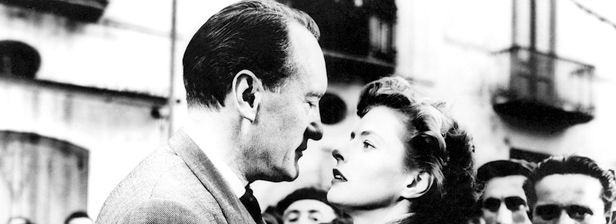Journey To Italy
Director: Roberto Rossellini
Cast: Ingrid Bergman, George Sanders, Maria Mauban
Length: 97 minutes
Country: Italy
Journey to Italy is one of those films where you have to pay attention; otherwise you may miss the point. Filmed at the end of the neo-realist period, it objectively looks at a marriage in dissolution, yet quietly bubbling underneath with unfulfilled romanticism. It features two excellent leads from the beautiful Ingrid Bergman, well renowned since Casablanca, and the terribly British George Sanders.
Alex (Sanders) and Katharine Joyce (Bergman) are on a car journey to Naples to sell off a villa inherited from a dead uncle. This sets the movie up like a road movie, but lacks any of the humour intrinsically related to the genre. Alex wishes to sell the villa off quickly and go home, whilst Katharine would like to stay for a few days and see the sights. From the villa they can see Mount Vesuvius, which is an ample visual metaphor for their marriage; it hasn’t exploded in eight years.
Alex, like most men in films released before the 70s, dislikes sentimentality, and is rarely seen without a drink. Katharine on the other hand, is more romantic, and wants to get a feel for the local culture. They argue about everything, leaving her to see the cultural sights by herself, and him to engage in half-hearted attempts on other women. She on the other hand ends up learning about Neapolitan culture in an almost documentary-like fashion as she is taken around the museums, and is affected by their preoccupation with the dead. Bergman successfully manages to convey the complexity of feeling so much towards life but also not being able to express it when she is with her husband. She tries to tell him about what she sees, but he never appears to be taking much interest.
The film invites us to open up and consider the significance of the world around us
Bergman proves once again that she was one of the greatest screen presences around. Not only is she impeccably beautiful and but she also has the ability to reveal more with a glance than with long declarative speeches. In one scene she is at the back of a room, and moves towards the camera until her whole face takes up the frame as she looks out of the window. In the simple composition of the shot, sympathy for Katharine is created, and we have gained a voyeuristic insight into her feelings. This is a delight to watch, especially as the long shot seems to be out of fashion nowadays, in favour of the music video editing of Nolan, Bay and Aronofsky.
The cinematography of exteriors is also worth mentioning. The use of landscape in this film is stunning, photographed in gorgeous black-and-white. There is one haunting scene at the end of the film where the couple walks around the ruins of Pompeii as they contemplate divorce, and this serves as a perfect backdrop to their crumbling marriage. The events they partake in are always affected by the landscape, even the ending, suggesting that the way we interact with one another is connected with something larger than us. The film invites us to open up and consider the significance of the world around us. Like the film itself, if you pay attention, you might find out what it is trying to tell you.
Initially released in 1954, it is now being rereleased by the British Film Institute as part of their series on Italian Neorealism. I would recommend it to anyone who likes movies where the quiet moments are the most interesting. For a film 60 years old, it feels surprisingly modern, and in the vein of In The Mood For Love, and Lost In Translation. A lot of people ask me why I love old films so much. I always say to them, “If a film’s great, it’s not old. It’s timeless.”

Comments